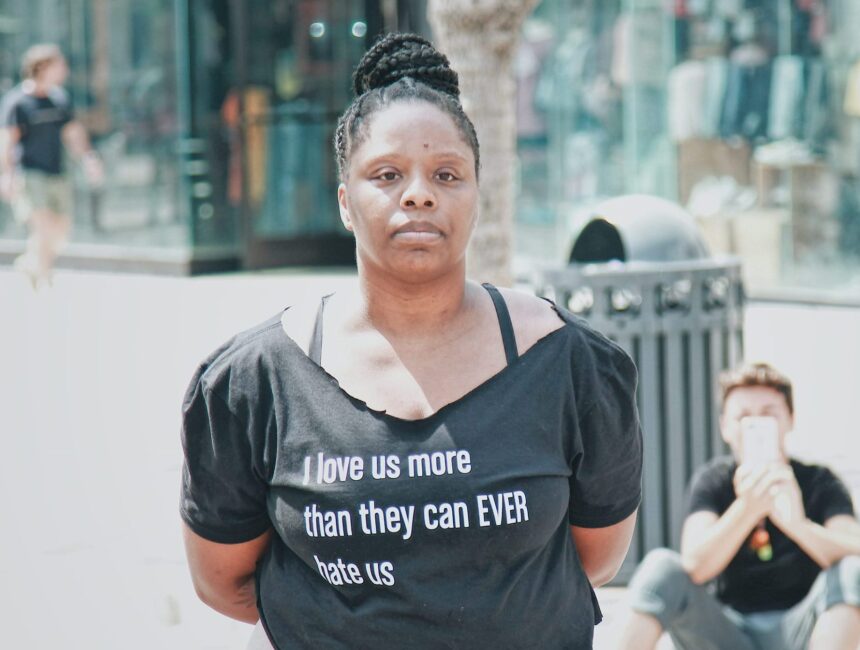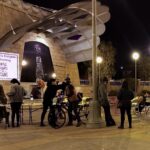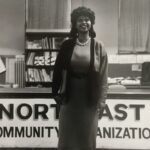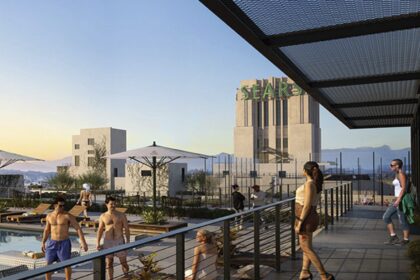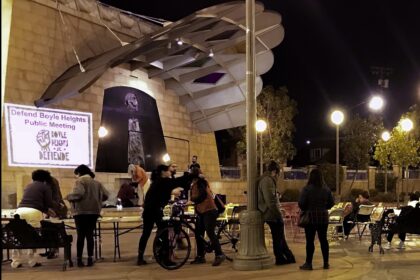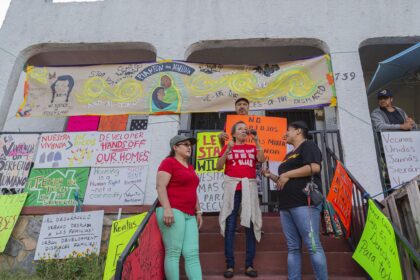Interview with Patrisse Cullors
Grant Kester
Patrisse Cullors is an artist, organizer, and freedom fighter from Los Angeles, California. Cofounder of Black Lives Matter and founder of Dignity and Power Now, she is also a performance artist, popular public speaker, and a New York Times bestselling author. She’s received many awards for activism and movement building, including being named by the Los Angeles Times as a Civil Rights Leader for the 21st Century and the Sydney Peace Prize for her work with Black Lives Matter. Patrisse recently completed an international tour for her new book When They Call You a Terrorist: A Black Lives Matter Memoir. This year Patrisse teamed up with digital media company blackpills to produce RESIST, a docu-series following her Los Angeles grassroots community’s efforts to stop a $3.5 billion jail expansion plan. In August 2018 Patrisse announced her new role as an adjunct professor at Arizona’s Prescott College where she will teach a course she created that examines, social practice, cultural work, and art impact on community organizing as part of the Social Justice & Community Organizing (SJCO) Master’s degree program. In 2019, she was promoted to Associate Professor. Patrisse is also completing her studies as a 2019 MFA candidate at the University of Southern California.
Thursday, May 2, 2019
GK: I want to start by asking you about your background in the arts and in performance and dance more generally.
PC: Where should I start?
GK: Was there a point when you were younger that you felt a sense of vocation to make art work of some kind? Or a point at which you first began to envision a future for yourself as an artist?
PC: I think every child has a playful, creative, imaginative nature… That’s just a part of normal development. I have a three-year old who’s doing make-believe all the time, making fake food and serving it and that sort of thing. So there’s that part of it. And then as you grow up that can get nurtured in you or it gets beat out of you (laughs). Or they try to beat it out of you and you keep going. I think for me, that part of me just kept going. Even if in my house it wasn’t being cultivated, I was cultivating it myself. I think what would be interesting to share is that I went to a performing arts school when I was in Junior High. It was just happenstance. My best friend’s mom signed both her and I up for the (admissions) lottery, and my friend didn’t get in but I did. It wasn’t because I was talented, it was literally a draw. I was like “I got the lottery!”. So, I started going to the Performing Arts magnet. Before then I had done these impromptu art shows for my great grandmother, like performance shows that I would do for her, and she would sit and laugh. I was lucky enough to have my great grandmother alive until I was twenty one. She would always say to me, “I’m going to put you in dance classes…” She never did, but she planted a seed. So, once I got to a Performing Arts magnet school in Junior High (Millikan Middle School in Sherman Oaks) I thought, “Oh, these are the dance classes that my grandmother was talking about. This is it!”.
Once I graduated from Junior High I was supposed to go to a Performing Arts High School but my mother didn’t sign me up and we actually ended up moving out of that neighborhood, and she didn’t want to have to take me to a school that far away. She also didn’t understand or realize that I could have been bussed in, and things like that. So I ended up going into the Yellow Pages (this was before Google) and I looked up dance studios in my neighborhood and I called, I was fourteen years old. I called every damn studio and asked them if they gave scholarships, so I could continue dancing. And I think that’s more interesting than my first artistic production because it shows you that there’s a kind of resilience, not just in me, but that is reflected in a lot of people who don’t have access to the arts. The minute we get that access it does something to us. It did something for me, because I was like “I have to keep doing this”. Even though I’m not going to be in school doing it, I need to be able to do it after school. I trained seven days a week. Every day I would walk myself to my dance studio and I would be there from four o’clock to nine pm. I did my homework in the dance studio, and I ended up joining the company, and I was there for four years. So that was the beginning of me thinking that my art could be a career of mine, like I’m going to be using this as a part of my life. Then there’s a whole evolution in how I moved away from dance into movement-based art and training with Augusto Boal, who was still alive at the time. I was fortunate enough to train with him for three years before he passed away.
GK: That’s an incredible opportunity.
PC: You have no idea, I was like 18, 19, 20. And then I was really introduced to the fine art world and to performance art. I think the first performance art I was witness to was in my early twenties. One of my good friends was going to Cal Arts, she was a dancer. I think when you’re a dancer and you hang out with the fine artists and performance artists your work shifts, because naturally you’re impacted by it. We all impact each other’s work. So, I started watching her do a bunch of weird shit [laughs] and I said, ‘that’s not dance!’. What is that? We’d come from a very strict dance studio, we used to dance together, it was very ballet-based. Anyway, that was the evolution that brought me into it all.
GK: So that led you from dance into performance and theater, and a lot of other things… Once you started to learn more about the performance art world, and traditions, were there particular practitioners you were drawn to or influenced by?
PC: Yes, definitely. One of the first people whose work I was really looking at was Narcissister, who I came across through my good friend Wanda, who was at Cal Arts, and who moved to New York to work as an assistant for Narcissister. And she said, “hey, check out this artist,” and I fell in love with the work. Narcissister has a dance background; she came out of Alvin Ailey. I assume that it was just too conservative for her, and she said, “I need to be doing different kinds of work.” So, I followed her career pretty intensely for a while, I saw her live, I was obsessed. The way she was thinking, the way she handled her body and her sexuality was just really brilliant to me. And I think now, like some of my contemporaries like Rafa Esparza or Lauren Halsey, whose performance work is brilliant and beautiful. E.J. Hill, who I love, and Nao Bustamante.
GK: Let me ask you a little bit about some of the current projects you’re working on, some of your recent performances. . . The POWER: From the Mouths of the Occupied project is really interesting, and I can see the connections there to Boal’s work and Pedagogy of the Oppressed. What was the first step in that project?
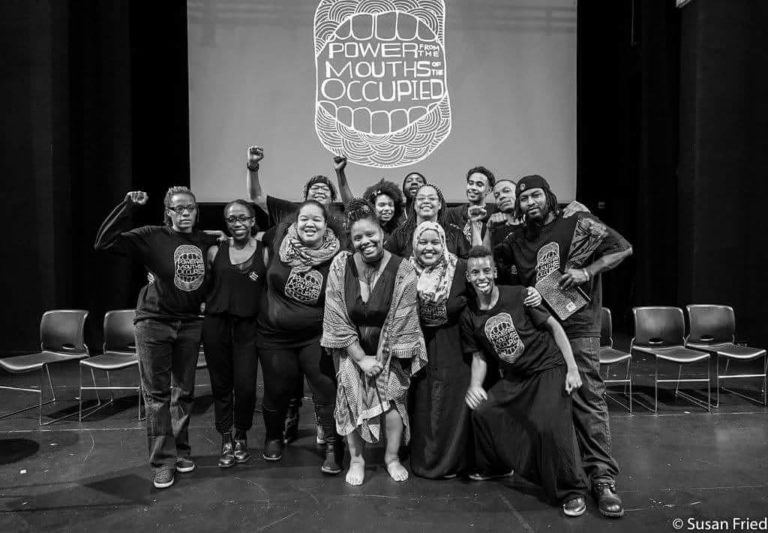
PC: I was asked to do an artist’s residency at Kalamazoo College, where they have a residency program for artists, and through that I met Lisa Brock (Academic Director of the Arcus Center for Social Justice Leadership and Associate Professor of History). So, I got the residency and then, a few months later my friend was killed. Black Lives Matter had already started, but that was sort of the height of Black Lives Matter. I went to Ferguson for about three days. . .
GK: That must have been very intense, and transformative.
PC: Very, very intense. . . And then I went straight to my residency. That trip (to Ferguson) impacted me and my art and everything else I was thinking about. I spent those twelve weeks thinking about what we need to do in order to talk about survival. I was fascinated with this idea that its only when a black person dies by police violence that we have a conversation about who they are. So, I got to know all about Mike Brown, but I only got to know all about him after his death. So many of us have experienced state violence and are survivors of state violence, or the everyday, mundane harassment of the police. What would it be like to tell those stories? So that’s where I really developed that piece. It was in Kalamazoo. I decided that it wasn’t going to be an ensemble cast that travels, but rather, it would be city-by-city. I wanted it to be place-based, so every place we went we developed a new cast and crew that was from that town. These weren’t actors, these were people who had actually experienced police violence. That was really important to my work. This was very much like Boal; we don’t need actors to tell our stories, we can tell our own stories. That was very much influenced by my years working under Boal and my years being involved in Theater of the Oppressed.
GK: I can really see that in the documentation of those performances. It makes such a profound difference when you have people on the stage manifesting their own experience. It’s not just a question of authenticity; there is something about the capacity to frame the experience of that violence that you can’t act out if you haven’t lived through it. I was really drawn to that project for that reason. Your description of Michael Brown’s killing and the way that came together with the residency, and the way in which that led to a shift in your consciousness is really interesting. It’s not that you weren’t thinking about a lot of these issues in your previous work, but it’s clear that something important changed in the nature of your practice as a result of that traumatic event. Can you talk a little about the Where Will You Go performance on the street in Santa Monica in 2018? How was that received in Santa Monica? How did it play out?

PC: The Third Street Promenade in Santa Monica is interesting because Third Street is used to performances, like live art. So, it was very normal, “Oh some artists on the Third Street Promenade yelling police or law enforcement commands”. That’s what we were doing. That was OK, it was well-received. We had a small talk-back afterwards. What was not well received was when we decided to move two blocks over to the newly-built three-story mall (Santa Monica Place). We were like, “let’s try it out over here”. Within seconds the whole piece came to life. It was literally within seconds that security came over and said, “you need to stop”. They sent a white woman over to tell us to stop. It was the piece; it was brilliant. We finished the piece and we were able to leave peacefully and no one was arrested. Santa Monica is Santa Monica, but Third Street has kind of kept its sanctity, like you can do live art or performance there. But the fact that only two blocks over it was so policed was just phenomenal.

GK: Yes, it make the exact point that the piece was trying to make about the pervasiveness of policing and the repression of public expression or dissent. I also really enjoyed the Evening of Cleansing performance. That’s seems like a really moving performance, based on the documentation. Given how much of your work is about trauma and violence I thought it was interesting to see a project about self-care and mindfulness and the spirit. I thought that balance was really nice.
PC: Thanks so much…

GK: My last question is a bigger picture question… How do you see the relationship between your artistic practice and your work as an activist and organizer? When I look at it, based on my own research, I see a lot of overlaps and relationships around the body and trauma, and the way that the body gets situated in a violent culture, such as our own. I just wanted to see if you any thoughts about how these two areas of your practice are related in your mind.
PC: Can you ask that again?
GK: There’s a certain modality of work that goes along with being an activist. There’s that recent essay you wrote for the Harvard Law Review, which involves a discursive component.[1] And then there’s an action-oriented component, being on the streets or in demonstrations and direct-action protest. And there’s an on-line component that involves communicating and exchanging information and mobilizing people and resources to deal with injustice, like the work you’re doing on the prison industrial complex. So, all of that work calls on a certain set of skills. The reason I asked this is because we often encounter a tendency to see activism and art-making as completely disparate undertakings. And what I really like about your work is that it represents an very complex body of artistic production that has a direct correlation with an equally complex body of activist practice. And maybe the answer for you is that you simply see them as extensions of each other. So, do you see ways in which the methodologies and the modes of thinking and being creative that are active in one of those domains, coming up in the other domain? Is there some kind of cross-fertilization?
PC: That’s a great question. I do not differentiate any of my works. They are all really connected and that connection feels very important to me; whether that’s my activism or my art or my teaching or my organizing. They all inform each other. So, in the abstract you could call my latest project performance art, but when you come out of it and you ask people “what did you feel like?”. People will say “I felt like I was in another world” or “I felt like I was healed,” I’m like, yeah, precisely. We can create environments, we can create other worlds. And that’s what I’m trying to do with my political work. My political work isn’t about the yelling and the protesting, it really is about trying to create a new world. I recognized why it’s so hard for me to work in a gallery. It’s because I don’t feel that my work gets its full expression inside a gallery. In fact, I chose to not do my latest work in the USC Gallery because I can’t build the world I need to inside those white walls. I need to be outside, I need to be in South Central; the community becomes the piece in the work. I think I’ve always known that about my work, but I really found that out with my last solo show, because I kind of left it thinking yeah, I like to build worlds. It’s like a big installation, like we’re walking into something. I think that’s really important.
GK: That makes a lot of sense. And you want to build worlds that are not closed off from other worlds. I would imagine that the feeling of being in the white cube space of the gallery is hard because that space is all about closure and autonomy and separation. So, when you have the survivors of police violence participating in a performance you break down that autonomy. You seek to cross-fertilize creative and emancipatory energies, between the experience of suffering and the transcendence of that suffering through resistance.
PC: Exactly.
GK: I’m wondering if you haven’t had that many people ask you about your artistic practice. And a lot of people just want to ask you about your activist practice…
Patrisse: That would be right (laughs). It’s deeply frustrating!
[1] Patrisse Cullors, “Abolition and Reparations: Histories of Resistance, Transformative Justice and Accountability,” Harvard Law Review, vol. 132, no. 6 (April 2019). https://harvardlawreview.org/2019/04/abolition-and-reparations-histories-of-resistance-transformative-justice-and-accountability/

